The Spatiotemporal Evolution of Extreme Climate Indices in the Songnen Plain and Its Impact on Maize Yield
Abstract
1. Introduction
2. Materials and Methods
2.1. Overview of the Study Area and Data Sources
2.2. Definition of Extreme Climate Indices
2.3. Method
2.3.1. Mann–Kendall Test
2.3.2. Inverse Distance Weight
2.3.3. Crop Yield Decomposition
2.3.4. Pearson Correlation Analysis
2.3.5. Random Forest
3. Analysis and Results
3.1. Analysis of Spatiotemporal Characteristics of Extreme Climate Indices
3.1.1. Characterization of Temporal Variations in Extreme Climate Indices during Maize Reproductive Period
3.1.2. Characterization of Spatial Variations in Extreme Climate Indices during Maize Reproductive Period
3.2. Characteristics of Maize Yield Changes in the Songnen Plain
3.3. Maize Yield Response to Extreme Climate Indices
4. Discussion
4.1. Spatiotemporal Variations in Extreme Climate Indices
4.2. Analysis of the Correlation between Maize Yield and Extreme Climate Indices
4.3. Impact of Extreme Climate on Food Security
5. Conclusions
Author Contributions
Funding
Data Availability Statement
Conflicts of Interest
References
- Zhang, J.; Guan, Q.; Zhang, Z.; Shao, W.; Zhang, E.; Kang, T.; Xiao, X.; Liu, H.; Luo, H. Characteristics of spatial and temporal dynamics of vegetation and its response to climate extremes in ecologically fragile and climate change sensitive areas—A case study of Hexi region. Catena 2024, 239, 107910. [Google Scholar] [CrossRef]
- Yang, Y.; Zhao, N.; Yue, T. Spatio-temporal variations of extreme high temperature event in China from 1980 to 2018. Sci. Geogr. Sin. 2022, 42, 536–547. [Google Scholar] [CrossRef]
- IPCC. Climate Change 2013: Managing the Risks of Extreme Events and Disaster to Advance Climate Change Adaptation; Cambridge University Press: Cambridge, UK, 2013. [Google Scholar]
- Bai, H.; Xiao, D.; Tang, J.; Liu, D.L. Evaluation of wheat yield in North China Plain under extreme climate by coupling crop model with machine learning. Comput. Electron. Agric. 2024, 217, 108651. [Google Scholar] [CrossRef]
- Yang, Y.; Chang, W.; Zhang, X. Spatiotemporal Variation of Extreme Climate and Its Correlation with Cotton Production in Xinjiang. Chin. J. Agric. Resour. Reg. Plan. 2024, 1–18. Available online: https://link.cnki.net/urlid/11.3513.S.20240229.1413.014 (accessed on 17 September 2024).
- Sun, H.; He, M.; Hu, M. Impact of global climatic warming on agricultural production in China. Chin. J. Agric. Resour. Reg. Plan. 2015, 36, 51–57. [Google Scholar] [CrossRef]
- Stott, P.A. How climate change affects extreme weather events. Science 2016, 352, 1517–1518. [Google Scholar] [CrossRef]
- Sisco, M.R.; Bosetti, V.; Weber, E.U. When do extreme weather events generate attention to climate change? Clim. Chang. 2017, 143, 227–241. [Google Scholar] [CrossRef]
- Schmidt, M.; Felsche, E. The effect of climate change on crop yield anomaly in Europe. Clim. Resil. Sustain. 2024, 3, e61. [Google Scholar] [CrossRef]
- Gao, Y.; Chen, W. Spatial and Temporal Variation of Extreme Temperature and Grain Yield Response in Liaoning Province from 1984 to 2020. Sci. Geogr. Sin. 2021, 41, 2052–2062. [Google Scholar] [CrossRef]
- Sun, Y.; Fan, W.; Shi, P.; Wang, Z.; Sun, S. The regional difference of the influence of climate change and management factors on cotton yield in Hubei province. Geogr. Res. 2021, 40, 1064–1077. [Google Scholar] [CrossRef]
- Han, D.; Zhao, J.; Hu, Q.; Pan, X.; Wang, P.; Yi, G.; Guo, Y.; Wang, H.; He, H.; Chen, L. Analysis of crop yield variation characteristics in Northeast China and the response to meteorological drought. J. China Agric. Univ. 2021, 26, 188–200. [Google Scholar] [CrossRef]
- Xu, Y.; Li, X.; Ge, Q.; Hao, Z. Effect of meteorological drought on cotton yield in Central Asia. Acta Geogr. Sin. 2022, 77, 2338–2352. [Google Scholar]
- Dhillon, R.; Takoo, G.; Sharma, V.; Nagle, M. Utilizing Machine Learning Framework to Evaluate the Effect of Climate Change on Maize and Soybean Yield. Comput. Electron. Agric. 2024, 221, 108982. [Google Scholar] [CrossRef]
- Gao, J.; Liu, L.; Guo, L.; Sun, D.; Liu, W.; Hou, W.; Wu, S. Synergic effects of climate change and phenological variation on agricultural production and its risk pattern in black soil region of Northeast China. Acta Geogr. Sin. 2022, 77, 1681–1700. [Google Scholar]
- Misganaw, A.; Addisu, S.; Alemayhu, G.; Kesete, N.; Khan, H. Crop production in northwestern Ethiopian highlands under changing climate. Int. J. Climatol. 2023, 43, 5797–5812. [Google Scholar] [CrossRef]
- Luo, N.; Meng, Q.; Feng, P.; Qu, Z.; Yu, Y.; Liu, D.L.; Müller, C.; Wang, P. China can be self-sufficient in maize production by 2030 with optimal crop management. Nat. Commun. 2023, 14, 2637. [Google Scholar] [CrossRef]
- Zhang, L.; Huang, Q.; Zhao, H.; Wu, Y. Temporal and Spatial Characteristics of Land Ecological Vulnerability in Songnen Plain, Heilongjiang Province. Chin. J. Soil Sci. 2023, 54, 505–515. [Google Scholar] [CrossRef]
- Li, P.; Huang, Q.; Huang, S.; Leng, G.; Peng, J.; Wang, H.; Zheng, X.; Li, Y.; Fang, W. Various maize yield losses and their dynamics triggered by drought thresholds based on Copula-Bayesian conditional probabilities. Agric. Water Manag. 2022, 261, 107391. [Google Scholar] [CrossRef]
- Xu, K.; Zhu, X.; Liu, Y.; Guo, R.; Chen, L. Effects of drought on maize yield under climate change in China. Trans. Chin. Soc. Agric. Eng. (Trans. CSAE) 2020, 36, 149–158. [Google Scholar] [CrossRef]
- Fu, Q.; Zhou, Z.; Li, T.; Liu, D.; Hou, R.; Cui, S.; Yan, P. Spatiotemporal characteristics of droughts and floods in northeastern China and their impacts on agriculture. Stoch. Environ. Res. Risk Assess. 2018, 32, 2913–2931. [Google Scholar] [CrossRef]
- Ren, L.; Zhou, T.; Zhang, W. Attribution of the record-breaking heat event over Northeast Asia in summer 2018: The role of circulation. Environ. Res. Lett. 2020, 15, 054018. [Google Scholar] [CrossRef]
- Tao, P.; Zhang, Y. Large-scale circulation features associated with the heat wave over Northeast China in summer 2018. Atmos. Ocean. Sci. Lett. 2019, 12, 254–260. [Google Scholar] [CrossRef]
- Li, E.; Zhao, J.; Pullens, J.W.M.; Yang, X. The compound effects of drought and high temperature stresses will be the main constraints on maize yield in Northeast China. Sci. Total Environ. 2022, 812, 152461. [Google Scholar] [CrossRef] [PubMed]
- Pei, Z.; Wu, B. Spatial-Temporal Characteristics of Spring Maize Drought in Songnen Plain, Northeast China. Water 2023, 15, 1618. [Google Scholar] [CrossRef]
- Guo, S.; Guo, E.; Zhang, Z.; Dong, M.; Wang, X.; Fu, Z.; Guan, K.; Zhang, W.; Zhang, W.; Zhao, J.; et al. Impacts of mean climate and extreme climate indices on soybean yield and yield components in Northeast China. Sci Total Environ. 2022, 838, 156284. [Google Scholar] [CrossRef]
- Wang, Y.; Shen, X.; Jiang, M.; Lu, X. Vegetation Change and Its Response to Climate Change between 2000 and 2016 in Marshes of the Songnen Plain, Northeast China. Sustainability 2020, 12, 3569. [Google Scholar] [CrossRef]
- Meng, F.; Li, T.; Fu, Q.; Liu, D.; Yang, L. Study on the calculation model of regional rainwater resource potential and its temporal and spatial distribution. J. Hydraul. Eng. 2020, 51, 556–568. [Google Scholar] [CrossRef]
- Du, C.; Wang, T.; Nie, T.; Dai, C.; Li, T. Water Surplus Deficit and Irrigation Schedule of Maize Based on CROPWAT Model. Water Sav. Irrig. 2020, 8, 91–97. [Google Scholar]
- Zhang, S.; Zhang, Y.; Sun, L.; Ji, R.; Cai, F.; Wu, J.; Li, G. Analysis of Distributional Characteristics and Primary Causes of Maize Drought in Northeast China. Chin. J. Agrometeorol. 2013, 34, 350–357. [Google Scholar] [CrossRef]
- Zhang, Z.; Zhang, L.; Liu, Y.; Jin, M. Responses of annual streamflow variability to annual precipitation, extreme climate events and large-scale climate phenomena in the Qinghai-Tibet Plateau. J. Hydrol. 2024, 632, 130969. [Google Scholar] [CrossRef]
- Gao, X.; Tao, Z.; Dai, J. Significant influences of extreme climate on autumn phenology in Central Asia grassland. Ecol. Indic. 2023, 155, 111056. [Google Scholar] [CrossRef]
- Zhao, Y.; Zheng, R.; Zheng, F.; Zhong, K.; Fu, J.; Zhang, J.; Flanagan, D.C.; Xu, X.; Li, Z. Spatiotemporal distribution of agrometeorological disasters in China and its impact on grain yield under climate change. Int. J. Disaster Risk Reduct. 2023, 95, 103823. [Google Scholar] [CrossRef]
- Che, X.; Li, H.; Zhang, C.; Guo, D.; Shen, H. Impacts of Climate Change on Corn Yield in Jilin Province Since 1980s. Res. Soil Water Conserv. 2021, 28, 230–234+241. [Google Scholar] [CrossRef]
- Liu, L.; Gou, X.; Wang, X.; Yang, M.; Qie, L.; Pang, G.; Wei, S.; Zhang, F.; Li, Y.; Wang, Q.; et al. Relationship between extreme climate and vegetation in arid and semi-arid mountains in China: A case study of the Qilian Mountains. Agric. For. Meteorol. 2024, 348, 109938. [Google Scholar] [CrossRef]
- Xu, L.; Cui, X.; Bian, J.; Wang, Y.; Wu, J. Dynamic change and driving response of shallow groundwater level based on random forest in southwest Songnen Plain. J. Hydrol. Reg. Stud. 2024, 53, 101800. [Google Scholar] [CrossRef]
- Sun, Z.; Wang, G.; Li, P.; Wang, H.; Zhang, M.; Liang, X. An improved random forest based on the classification accuracy and correlation measurement of decision trees. Expert Syst. Appl. 2024, 237, 121549. [Google Scholar] [CrossRef]
- Elith, J.; Leathwick, J.R.; Hastie, T. A working guide to boosted regression trees. J. Anim. Ecol. 2008, 77, 802–813. [Google Scholar] [CrossRef]
- Li, X.; Xu, R. High-Dimensional Data Analysis in Cancer Research; Springer: Berlin/Heidelberg, Germany, 2009. [Google Scholar] [CrossRef]
- Han, T.; Yang, B.-S.; Lee, S.-J. Application of Random Forest Algorithm in Machine Fault Diagnosis. In Proceedings of the 1st World Congress on Engineering Asset Management, WCEAM 2006, Gold Coast, Australia, 11–14 July 2006. [Google Scholar] [CrossRef]
- Ren, Z.; Zhao, H.; Mu, X.; Xu, Q.; Shi, K.; Yang, G. Spatiotemporal variations of extreme weather events and climate drivers in the Three Gorges Reservoir Area and its surrounding regions from 1960 to 2020. Atmos. Res. 2024, 304, 107379. [Google Scholar] [CrossRef]
- Jiang, S.; Han, T.; Zhou, B.; Zhang, Q.; Hao, X.; Li, H. Characteristics of clustered heavy precipitation events at Northeast China and associated atmospheric circulations. Clim. Dyn. 2023, 61, 5935. [Google Scholar] [CrossRef]
- Wang, C.; Zhang, W.; Wang, J. The path analysis of spatial-temporal changes and productivity improvement of grain supply in china. Chin. J. Agric. Resour. Reg. Plan. 2023, 1–15. Available online: https://link.cnki.net/urlid/11.3513.S.20231117.1641.004 (accessed on 17 September 2024).
- Wang, Y.; Zhang, S.; Xu, Y.; Que, L.; Li, X.; Huang, Y.; Chen, X.; Wang, l. Meteorological drought and atmospheric circulation anomalies characteristics in Heilongjiang Province from May to September in recent 50 years. J. Arid Meteorol. 2023, 41, 540–549. [Google Scholar] [CrossRef]
- Lobell, D.B.; Field, C.B. Global scale climate–crop yield relationships and the impacts of recent warming. Environ. Res. Lett. 2007, 2, 014002. [Google Scholar] [CrossRef]
- Liu, D.; Zhang, J.; Zhao, L.; Zhao, S.; Cui, G. The positive impact of extreme heat on vegetation growth in Northeast Asia. Agric. For. Meteorol. 2024, 347, 109918. [Google Scholar] [CrossRef]
- Liu, X.; Fu, B. Drought impacts on crop yield: Progress, challenges and prospect. Acta Geogr. Sin. 2021, 76, 2632–2646. [Google Scholar]
- Liu, X.; Chang, X.; Wang, Y.; Wang, D.; Wang, X.; Meng, Q.; Wang, P. Adaptation to priming drought at six-leaf stage relieves maize yield loss to individual and combined drought and heat stressors around flowering. Environ. Exp. Bot. 2024, 224, 105799. [Google Scholar] [CrossRef]
- Liu, H.; Tang, X.; Yang, L. Approach for Evaluating Summer Maize Yield Losses under Extreme Rainfall Events:A Case Study in “7·20” Heavy Rain Event in Henan Province. J. Irrig. Drain. 2023, 42, 1–6. [Google Scholar] [CrossRef]
- Yan, G.; Qi, F.; Wei, L.; Aigang, L.; Yu, W.; Jing, Y.; Aifang, C.; Yamin, W.; Yubo, S.; Li, L.; et al. Changes of daily climate extremes in Loess Plateau during 1960–2013. Quat. Int. 2015, 371, 5–21. [Google Scholar] [CrossRef]
- Zhang, D.; Zheng, J.; Fan, J.; Fang, Z.; Ji, Q.; Yuan, Y.; Liu, W. Spatiotemporal Variations of Extreme Temperature Indices in Different Climatic Zones of China over the Past 60 Years. Chin. J. Agrometeorol. 2019, 40, 422–434. [Google Scholar] [CrossRef]
- Lang, X.; Sui, Y. Changes in mean and extreme climates over China with a 2 °C global warming. Chin. Sci. Bull. 2013, 58, 1453–1461. [Google Scholar] [CrossRef]
- Hou, W. The Method to Detect as Well as Assess the Extreme Climate Events and the Spatial and Temporal Characteristies of Changes of Temperature and Precipitation Extremes over China during the Second Half of the 20th Century. Ph.D. Thesis, Lanzhou University, Lanzhou, China, 2009. [Google Scholar]
- Li, S.; Lian, Y.; Chen, S.; Sun, Q.; Yao, Y. Distribution of Extreme Cool Events over Northeast China in Early Summer and the Related Dynamical Processes. Sci. Geogr. Sin. 2012, 32, 752–758. [Google Scholar] [CrossRef]
- Liang, F.; Liu, D.; Wang, W.; Zhang, F.; Yu, F. Temporal and spatial variability of summer extreme precipitation events in Northeast China during 1961-2013. Arid Land Geogr. 2016, 39, 565–572. [Google Scholar] [CrossRef]
- Zhou, G.; Dong, L.; Wang, H.; Liu, D. Overview of typhoon activities over western North Pacific and the South China Sea in 2020. J. Mar. Meteorol. 2021, 41, 1–10. [Google Scholar] [CrossRef]
- Li, H.; Luan, C.; Xia, X.; Chen, C.; Sun, R.; Wang, H.; Li, B. Prediction of future extreme precipitation scenarios in China based on CMIP6 climate model. Water Resour. Hydropower Eng. 2023, 54, 16–29. [Google Scholar] [CrossRef]
- Du, H. Research on the Extreme Climate Events over Northeast China under Global Climate Change. Ph.D. Thesis, Northeast Normal University, Changchun, China, 2015. [Google Scholar]
- Zhao, J.; Yang, X.; Liu, Z. Influence of climate warming on serious low temperature and cold damage and cultivation pattern of spring maize in Northeast China. Acta Ecol. Sin. 2009, 29, 6544–6551. [Google Scholar]
- Yin, X.; Wang, M.; Kong, Q.; Wang, Z.; Zhang, H.; Chu, Q.; Wen, X.; Chen, F. Impacts of high temperature on maize production and adaptation measures in Northeast China. Chin. J. Appl. Ecol. 2015, 26, 186–198. [Google Scholar] [CrossRef]
- Wang, T.; Li, N.; Li, Y.; Lin, H.; Yao, N.; Chen, X.; Li Liu, D.; Yu, Q.; Feng, H. Impact of climate variability on grain yields of spring and summer maize. Comput. Electron. Agric. 2022, 199, 107101. [Google Scholar] [CrossRef]
- Bi, X.; Liu, X.; Ma, D.; Liu, J. Lag response of vegetation NDVI to climate factors in Liaoning Province. Chin. J. Agric. Resour. Reg. Plan. 2021, 42, 233–244. [Google Scholar]
- Akpa, A.F. The effects of climate extreme events on selected food crop yields in Sub-Saharan Africa. Heliyon 2024, 10, e30796. [Google Scholar] [CrossRef]
- Vogel, E.; Donat, M.G.; Alexander, L.V.; Meinshausen, M.; Ray, D.K.; Karoly, D.; Meinshausen, N.; Frieler, K. The effects of climate extremes on global agricultural yields. Environ. Res. Lett. 2019, 14, 054010. [Google Scholar] [CrossRef]
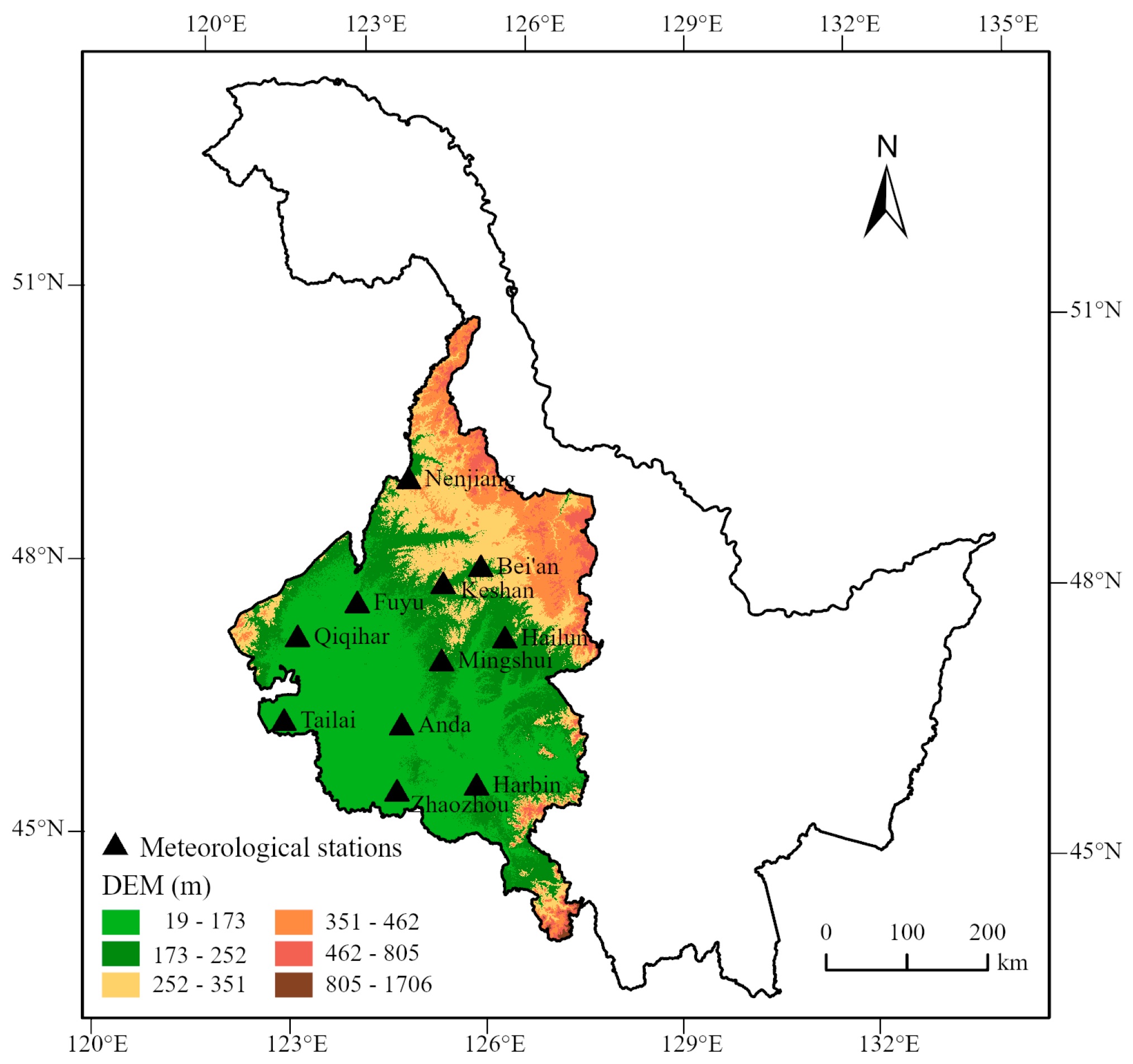

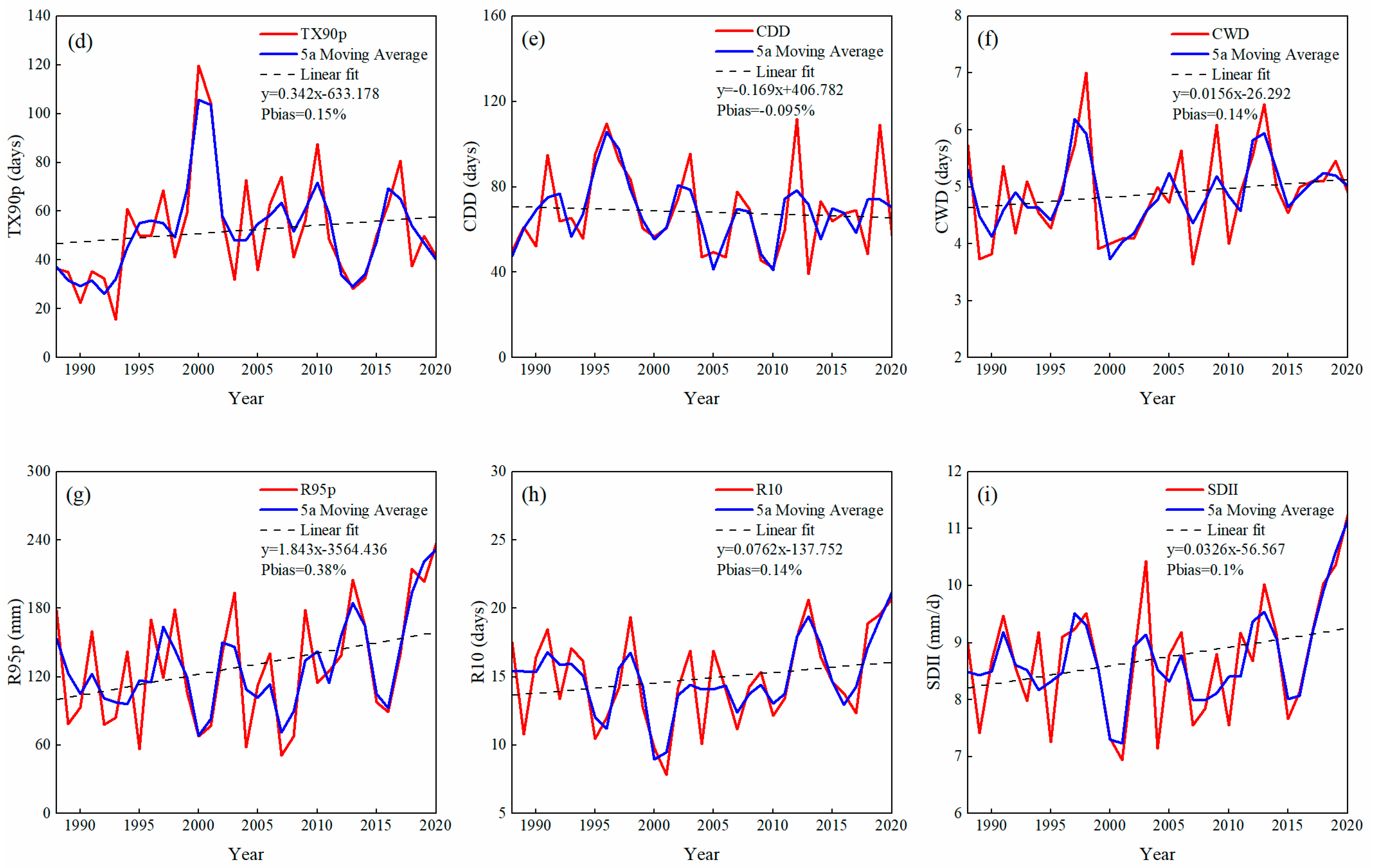
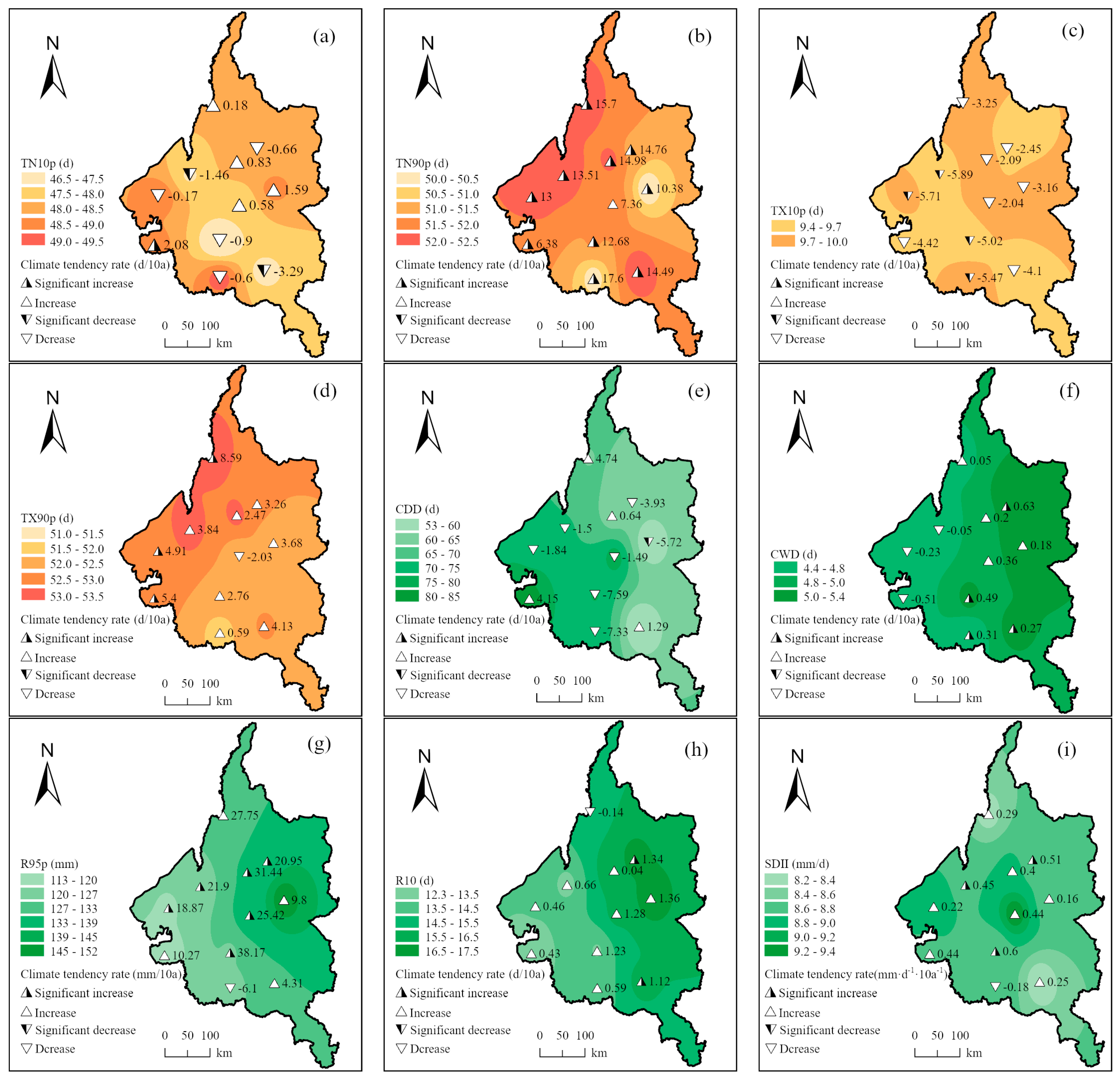

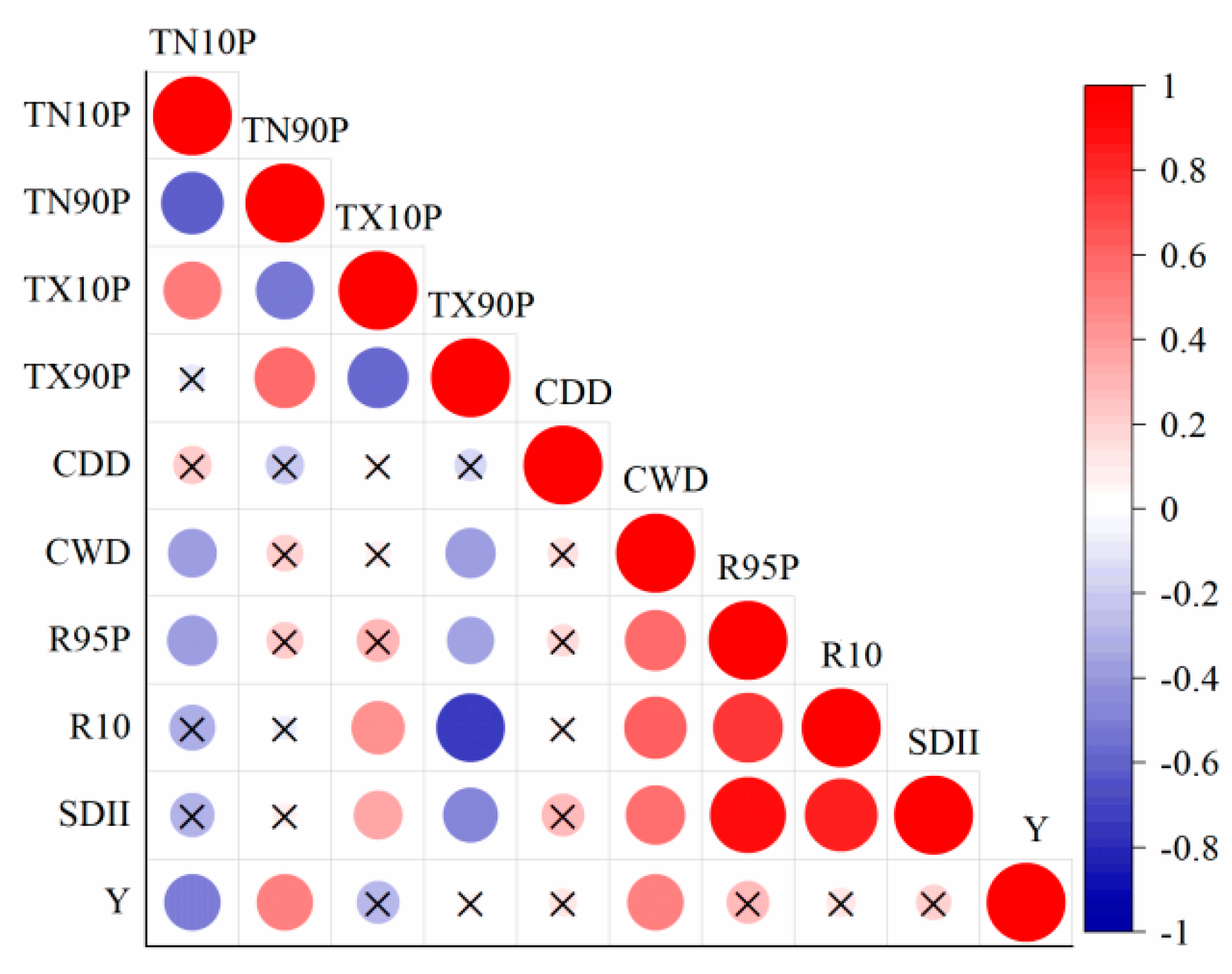
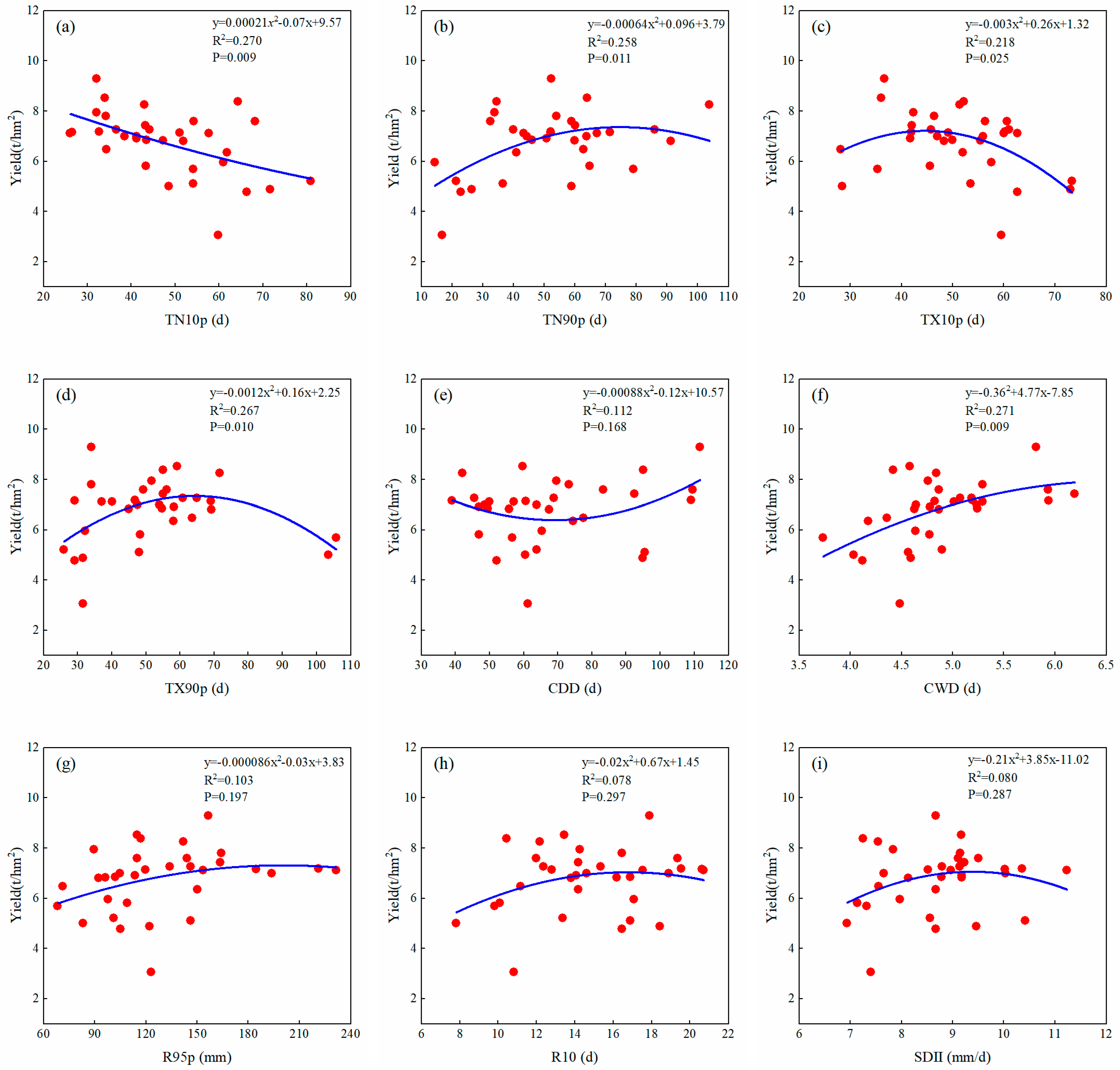
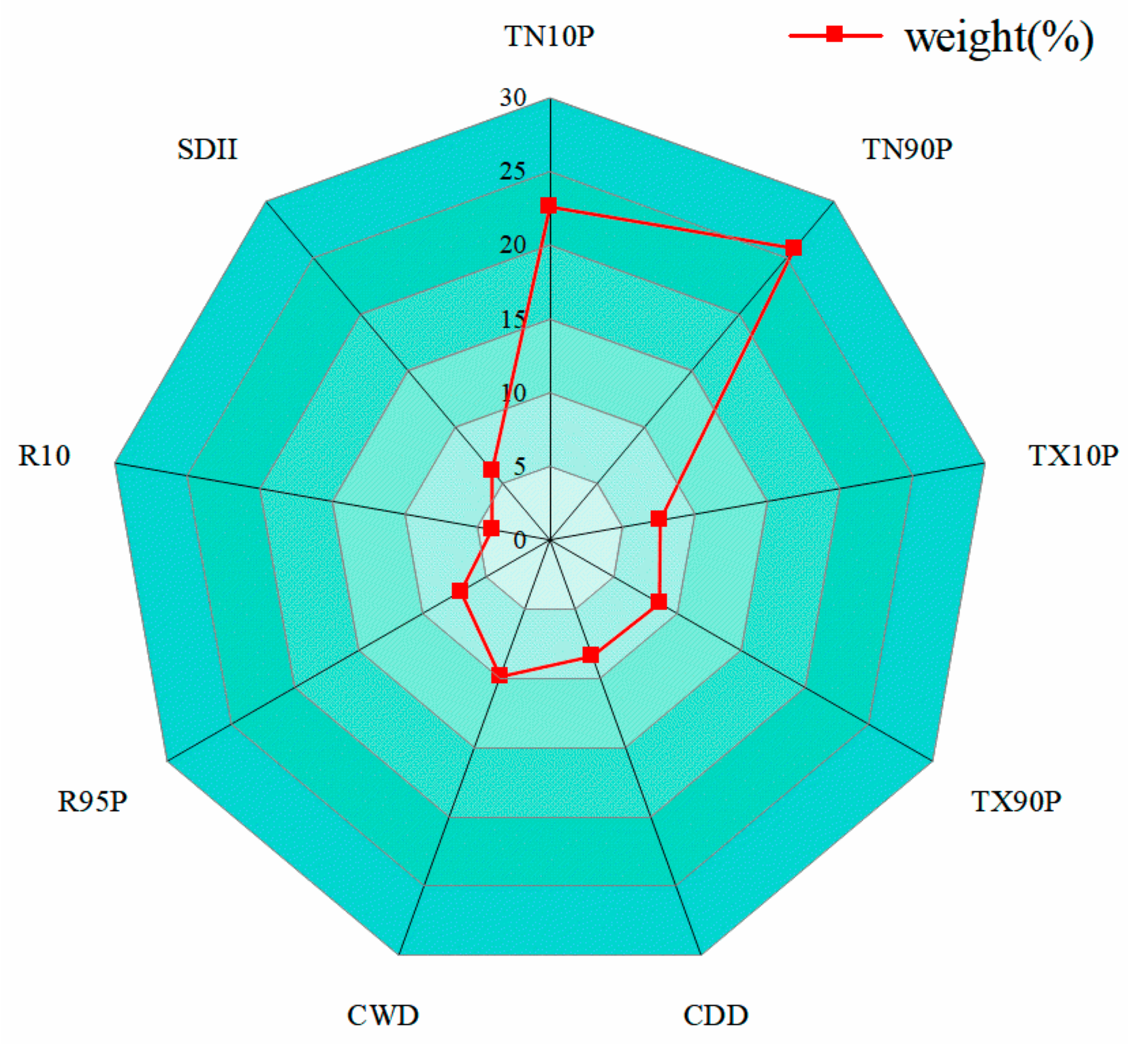
| Name | Abbreviation | Define | Unit |
|---|---|---|---|
| Number of Cold Nights | TN10p | The number of days with the lowest temperature below the 10th percentile | d |
| Number of Warm Night Days | TN90p | The number of days with the lowest temperature >90th percentile | d |
| Number of Cold Days | TX10p | The number of days with the highest temperature below the 10th percentile | d |
| Number of Warm Days | TX90p | The number of days with the highest temperature >90th percentile | d |
| Continuous Drought Days | CDD | The longest consecutive days with precipitation less than 1 mm | d |
| Continuous Wet Days | CWD | The longest consecutive days with precipitation ≥1 mm | d |
| Heavy Precipitation | R95p | Total precipitation >95th percentile | mm |
| Number of Days with Heavy Rainfall | R10 | The number of days with daily precipitation ≥10 mm | d |
| Daily Precipitation Intensity | SDII | The ratio of total precipitation to days with a precipitation of ≥1 mm | mm/d |
Disclaimer/Publisher’s Note: The statements, opinions and data contained in all publications are solely those of the individual author(s) and contributor(s) and not of MDPI and/or the editor(s). MDPI and/or the editor(s) disclaim responsibility for any injury to people or property resulting from any ideas, methods, instructions or products referred to in the content. |
© 2024 by the authors. Licensee MDPI, Basel, Switzerland. This article is an open access article distributed under the terms and conditions of the Creative Commons Attribution (CC BY) license (https://creativecommons.org/licenses/by/4.0/).
Share and Cite
Tang, B.; Meng, F.; Dong, F.; Zhang, H.; Meng, B. The Spatiotemporal Evolution of Extreme Climate Indices in the Songnen Plain and Its Impact on Maize Yield. Agronomy 2024, 14, 2128. https://doi.org/10.3390/agronomy14092128
Tang B, Meng F, Dong F, Zhang H, Meng B. The Spatiotemporal Evolution of Extreme Climate Indices in the Songnen Plain and Its Impact on Maize Yield. Agronomy. 2024; 14(9):2128. https://doi.org/10.3390/agronomy14092128
Chicago/Turabian StyleTang, Bowen, Fanxiang Meng, Fangli Dong, Hengfei Zhang, and Bo Meng. 2024. "The Spatiotemporal Evolution of Extreme Climate Indices in the Songnen Plain and Its Impact on Maize Yield" Agronomy 14, no. 9: 2128. https://doi.org/10.3390/agronomy14092128
APA StyleTang, B., Meng, F., Dong, F., Zhang, H., & Meng, B. (2024). The Spatiotemporal Evolution of Extreme Climate Indices in the Songnen Plain and Its Impact on Maize Yield. Agronomy, 14(9), 2128. https://doi.org/10.3390/agronomy14092128






